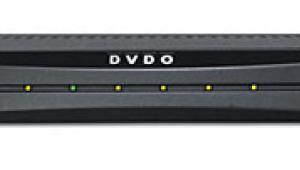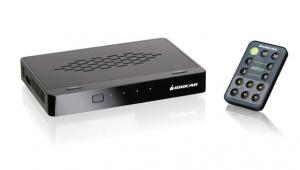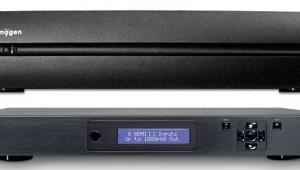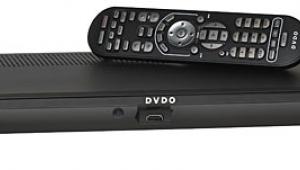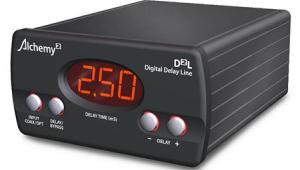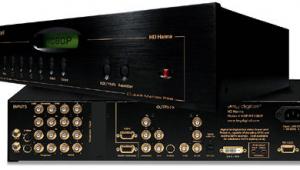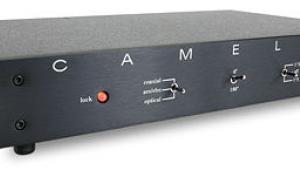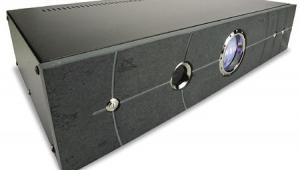TacT Audio TCS mkII Pre/Pro and Room-Correction System
The room-correction band-wagon is already rolling across the home theater plain, and it's rapidly gaining momentum with each new batch of model releases. Several products, from the highest-end pre/pros to the lowest-end receivers, are touting room assistance these days. This is hardly surprising—in fact, the more-surprising part is that it's taken this long for the broader run of electronics manufacturers to embrace the idea. After all, room interaction will always be the single most important factor, by far, in making an audio system sound right in its particular listening environment. Naturally, it's in the manufacturer's best interest to provide as much help as possible. Fair or not, the vast majority of users are going to blame the product, not the room, when they hook up their system and it doesn't sound good. Considering the challenges that the vast majority of users' listening environments are going to present, it's easy to see why even a little correction could go a long way.
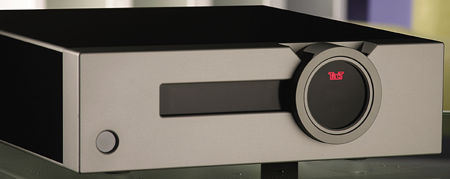
One company that helped build the room-correction bandwagon is TacT Audio. They've been at it about as long as anybody and are still held up as a standard of how to do digital room correction properly. The TCS mkII (TCS stands for Theater Correction System, which tells you what kind of role the correction plays in this device) is their latest room wizard, and it brings their unique system to a multichannel platform.
Making the Connection
The TCS mkII is also a fully functional pre/pro. It offers the full Dolby and DTS complements, including EX and ES, plus Pro Logic II and Neo:6, with a modular design that will let you add future processing modes. There are nine digital inputs (six SPDIF, one AES/EBU, one Toslink, and one proprietary FireWire connection). Ten digital outputs are available (primarily for use with TacT's digital amplifiers), with five SPDIF jacks and five AES/EBU jacks. Both sets of five outputs mirror the same 10 output channels; in other words, you can output both the left and right front signal through one SPDIF or one AES/EBU jack; same thing with the surround left and right, center and LFE, Aux 1 and 2, and Aux 3 and 4. You can use the four auxiliary channels in a variety of ways.
Analog connections include six single-ended input pairs and one balanced (XLR). TacT provides single-ended outputs for all 10 output channels, along with balanced (XLR) outputs for the front right, left, and center. They use top-shelf, 24-bit analog-to-digital and digital-to-analog converters for all of the analog inputs and outputs. There's also two RS-232 connections, two trigger outputs, and an input for the supplied, TacT-calibrated microphone that you use in the room-correction process.

The TCS mkII's primary focus is its room-correction system, plus the fundamentals of audio switching and processing. As a result, it doesn't have some features that you would find on other high-end pre/pros. For many, the most obvious omission is the lack of video connections. This is no loss in my book, as video switching is hardly a necessary function for an audio pre/pro, and some will argue that the potential for interference is well worth its deletion. More unfortunate is the lack of a multichannel analog input for use with multichannel SACD or DVD-Audio. Naturally, you can still use their two-channel varieties. There's also no support for secondary zones.
Get Corrected
What the TCS mkII does have is the most advanced room-correction system I've ever used, in an implementation that's still surprisingly easy to operate, despite its complexity and capability. You can perform a good deal of the setup process with the remote and front-panel display; however, to take full advantage, you'll need your PC and the included room-correction software. With that, you get what, in my experience so far, is unprecedented control over virtually every aspect of room interaction to go along with the more-basic considerations that the TCS mkII's setup includes, like bass management and speaker level, distance, and phase.
Far beyond simple equalization, the TacT system, now in its fourth generation, is a true correction system that begins with an impulse-response measurement using the microphone mounted in the primary listening position. The software then generates a graphic representation of room response, which you can fix using the TCS mkII's real-time correction hardware by drawing your own desired frequency curve, rather than automatically trying to simply flatten everything out. If you want everything flat (or as close to flat as possible), draw your curve accordingly. However, if you know your room and speakers well, you can accommodate response irregularities and personal taste via the shape of your curve that you couldn't with an auto-flat system.
To say the system is precise is a serious understatement. Correction takes place with a frequency resolution of 1 hertz and is accurate to below 20 Hz. You can correct each channel individually, and
10 programmable presets are available for saving your work. A bypass preset will circumvent all correction, so you have an easy opportunity to compare the tweaks you've made with an unaltered version.
The full capabilities of TacT's room correction and setup systems deserve more space than we can give them here, but that's life in the magazine business. I put the TCS mkII to work with a Revel F50 speaker system and an Aerial LR3 array. Lexicon's seven-channel LX-7 and Simaudio's seven-channel Aurora supplied power. Lexicon's RT-10 universal player and Simaudio's Orion DVD player also provided signals.
The Results Are. . .
The effects of the TCS mkII's correction were immediately clear—and would be to anyone, untrained ear or not. Keep in mind, the TCS mkII is a world-class preamplifier, and its sound is exceptionally impressive without correction. Even with two-channel, 16-bit/
 44.1-kilohertz material, though, the instant upgrades in low-frequency clarity and precision, soundstage depth, and imaging were highly significant—and obvious. As good as our listening room is, it has its quirks. There's a notable spike around 40 Hz that mucks things up at times, but the TCS mkII tamed it far better than anything I've thrown at it yet. It didn't eliminate the spike's effect entirely—no system could—but it relegated it to virtual non-issue status, much to my surprise.
44.1-kilohertz material, though, the instant upgrades in low-frequency clarity and precision, soundstage depth, and imaging were highly significant—and obvious. As good as our listening room is, it has its quirks. There's a notable spike around 40 Hz that mucks things up at times, but the TCS mkII tamed it far better than anything I've thrown at it yet. It didn't eliminate the spike's effect entirely—no system could—but it relegated it to virtual non-issue status, much to my surprise.
We all know that high-resolution material offers more clarity, space, and depth, but this doesn't mean room corrections still won't have a tremendous effect on how those benefits are realized in the listening space. Even though limited to two-channel, I heard stage depth, stability, and separation in Bucky Pizzarelli's Swing Live SACD (Chesky) like I've never heard before, not to mention pinpoint accuracy from the top of the frequency response to the bottom. The two-channel SACD rendition of Muddy Waters' Folk Singer (MCA) offered up more of the same, despite the less-advanced production values of its original tracks, having been recorded in the '60s. The remarkable realism that the TCS mkII delivered here was a portal through time. It's about as close as I'll probably ever get to hearing the king of electric blues in person.
The good folks at TacT are well aware that realism with movies is no less important for a fully rounded pre/pro. After all, it's the enveloping sound from our speakers, not the limited visuals from our screen, that ultimately make us feel like we're really on Omaha Beach or in Middle Earth. Bass was the first thing to catch my ear, as I've never heard it sound tighter, more controlled, or more impactful in our listening room. The large artillery reports from Saving Private Ryan and the plentiful low-frequency events from the Lord of the Rings trilogy—particularly the mammoth footfalls from Return of the King—attacked with fervor, climaxed with authority, and decayed naturally and effectively.
Soundstage precision was among the more-remarkable aspects of the TCS mkII's movie performance, particularly as sounds transitioned from the front speakers to the rear. Long circular pans, such as the droid revolving around the Sith's head in The Phantom Menace, were eerily realistic. The TCS mkII unveiled considerably more space and presence in the surround field with most any movie I ran through it.
There are a lot of opportunities right now to get room correction in one form or another, and that will only continue. Some of these systems are good, some aren't so good, and some are flat-out smoke and mirrors. It's impossible to overestimate the value of quality room correction, though; for that, you better look to companies that not only have experience but also have the research and design capabilities necessary to put effective room correction into a product that actually works.
At $9,900, TacT's TCS mkII is obviously not for everyone; however, between the top-shelf quality of its internal components and design and the top-shelf quality of its correction system, it's easy to say that it provided some of the most realistic, natural music and movie experiences that I've had in this listening room. . .or any other.
Highlights
• Top-shelf audio preamplifier with surround processing, to boot
• Most effective room-correction system I've used
- Log in or register to post comments
